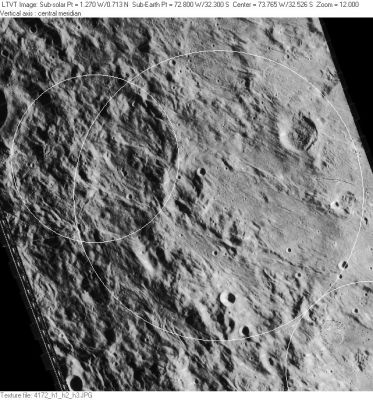Difference between revisions of "Lagrange"
(Created page with "<div id="content_view" class="wiki" style="display: block"> =Lagrange= {| class="wiki_table" | Lat: 32.3°S, Long: 72.8°W, Diam: 225 km, Depth: 2.4 km, Rükl: 61<br /> |}...") |
|||
| (2 intermediate revisions by the same user not shown) | |||
| Line 5: | Line 5: | ||
|} | |} | ||
<div id="toc"> | <div id="toc"> | ||
| − | + | [http://www.lpod.org/coppermine/albums/userpics/Lagrange_LO-IV-172H_LTVT.JPG [[Image:Normal_Lagrange_LO-IV-172H_LTVT.JPG|external image normal_Lagrange_LO-IV-172H_LTVT.JPG]]]<br /> ''[http://lpod.org/coppermine/displayimage.php?pos=-2697 LO-IV-172H]'' This area of the Moon is thickly blanketed with ejecta from nearby [[Mare%20Orientale|Mare Orientale]] making large craters difficult to recognize unless the Sun is very low. '''Lagrange''' is in the center of this view with its IAU position and diameter represented by the large circle. The actual depression seems considerably smaller and somewhat displaced to the southeast. On the west, the second largest circle represents 130-km diameter '''Lagrange R''', which partially overlays '''Lagrange'''. In the lower right corner, the IAU circle marks the rim of 134-km [[Piazzi|Piazzi]].<br /> <br /> | |
| − | |||
==Images== | ==Images== | ||
[http://www.lpod.org/coppermine/thumbnails.php?album=search&type=full&search=Lagrange LPOD Photo Gallery] [http://www.lpi.usra.edu/resources/lunar_orbiter/bin/srch_nam.shtml?Lagrange%7C0 Lunar Orbiter Images]<br /> The Hi-Res scan of Lunar Orbiter 4's photograph [http://www.lpi.usra.edu/resources/lunarorbiter/images/preview/4160_h3.jpg LOIV-160-h3] shows Concentric Crater '''Lagrange T''' very well! (leftward of the frame's centre).<br /> Research: Danny Caes<br /> <br /> | [http://www.lpod.org/coppermine/thumbnails.php?album=search&type=full&search=Lagrange LPOD Photo Gallery] [http://www.lpi.usra.edu/resources/lunar_orbiter/bin/srch_nam.shtml?Lagrange%7C0 Lunar Orbiter Images]<br /> The Hi-Res scan of Lunar Orbiter 4's photograph [http://www.lpi.usra.edu/resources/lunarorbiter/images/preview/4160_h3.jpg LOIV-160-h3] shows Concentric Crater '''Lagrange T''' very well! (leftward of the frame's centre).<br /> Research: Danny Caes<br /> <br /> | ||
==Maps== | ==Maps== | ||
| − | ''([ | + | ''([[LAC%20zone|LAC zone]] 109B1)'' [http://planetarynames.wr.usgs.gov/images/Lunar/lac_109.pdf USGS Digital Atlas PDF]<br /> <br /> |
==Description== | ==Description== | ||
<br /> | <br /> | ||
==Description: Elger== | ==Description: Elger== | ||
| − | ''([ | + | ''([[IAU%20directions|IAU Directions]])'' LAGRANGE.--A larger but similar formation, 100 miles in diameter, associated with [[Piazzi|Piazzi]] on the N.W., with a complex terraced border, including peaks of 9,000 feet, a bright crater on the E., and a ring-plain on the N.E. The inner slope of the W. wall is a fine object at sunrise, when libration is favourable. The floor is dark and devoid of detail.<br /> <br /> |
==Description: Wikipedia== | ==Description: Wikipedia== | ||
[http://en.wikipedia.org/wiki/Lagrange_(crater) Lagrange]<br /> <br /> | [http://en.wikipedia.org/wiki/Lagrange_(crater) Lagrange]<br /> <br /> | ||
==Additional Information== | ==Additional Information== | ||
| − | * Depth data from [ | + | * Depth data from [[Kurt%20Fisher%20Crater%20Depths|Kurt Fisher database]] |
** Cherrington, 1969: 2.4 km | ** Cherrington, 1969: 2.4 km | ||
* [http://lpod.org/coppermine/displayimage.php?pos=-825 Lagrange T] concentric crater. | * [http://lpod.org/coppermine/displayimage.php?pos=-825 Lagrange T] concentric crater. | ||
| Line 26: | Line 25: | ||
* Joseph Louis; Italian mathematician (1736-1813). | * Joseph Louis; Italian mathematician (1736-1813). | ||
| − | * According to ''[ | + | * According to ''[[Whitaker|Whitaker]]'' (p. 220), this name was introduced by [[M%C3%A4dler|Mädler]]. |
* Crater Lagrange B was called '''''Fresa''''' by Hugh Percy Wilkins and Patrick Moore, but the I.A.U. did not accept that name. | * Crater Lagrange B was called '''''Fresa''''' by Hugh Percy Wilkins and Patrick Moore, but the I.A.U. did not accept that name. | ||
* Fresa was an Italian astronomer (Alfonso Fresa?). | * Fresa was an Italian astronomer (Alfonso Fresa?). | ||
| Line 33: | Line 32: | ||
[http://lpod.wikispaces.com/October%2019%2C%202008 Bumpy, Lumpy, and Where?] (see this LPOD's discussion)<br /> <br /> | [http://lpod.wikispaces.com/October%2019%2C%202008 Bumpy, Lumpy, and Where?] (see this LPOD's discussion)<br /> <br /> | ||
==Bibliography== | ==Bibliography== | ||
| − | Lagrange B ("Fresa"): [ | + | Lagrange B ("Fresa"): [[Wilkins%20and%20Moore|THE MOON]] by H.P.Wilkins and P.Moore.<br /> <br /> |
---- | ---- | ||
| − | + | </div> | |
Latest revision as of 03:00, 16 April 2018
Contents
Lagrange
| Lat: 32.3°S, Long: 72.8°W, Diam: 225 km, Depth: 2.4 km, Rükl: 61 |
LO-IV-172H This area of the Moon is thickly blanketed with ejecta from nearby Mare Orientale making large craters difficult to recognize unless the Sun is very low. Lagrange is in the center of this view with its IAU position and diameter represented by the large circle. The actual depression seems considerably smaller and somewhat displaced to the southeast. On the west, the second largest circle represents 130-km diameter Lagrange R, which partially overlays Lagrange. In the lower right corner, the IAU circle marks the rim of 134-km Piazzi.
Images
LPOD Photo Gallery Lunar Orbiter Images
The Hi-Res scan of Lunar Orbiter 4's photograph LOIV-160-h3 shows Concentric Crater Lagrange T very well! (leftward of the frame's centre).
Research: Danny Caes
Maps
(LAC zone 109B1) USGS Digital Atlas PDF
Description
Description: Elger
(IAU Directions) LAGRANGE.--A larger but similar formation, 100 miles in diameter, associated with Piazzi on the N.W., with a complex terraced border, including peaks of 9,000 feet, a bright crater on the E., and a ring-plain on the N.E. The inner slope of the W. wall is a fine object at sunrise, when libration is favourable. The floor is dark and devoid of detail.
Description: Wikipedia
Additional Information
- Depth data from Kurt Fisher database
- Cherrington, 1969: 2.4 km
- Lagrange T concentric crater.
- In C.A.Wood's list of 1978 there seems to be two different locations of this Concentric Crater. One is Lagrange T itself (number 40), and the other is mentioned as "near Lagrange T" (number 39). Who's who?
Nomenclature
- Joseph Louis; Italian mathematician (1736-1813).
- According to Whitaker (p. 220), this name was introduced by Mädler.
- Crater Lagrange B was called Fresa by Hugh Percy Wilkins and Patrick Moore, but the I.A.U. did not accept that name.
- Fresa was an Italian astronomer (Alfonso Fresa?).
LPOD Articles
Bumpy, Lumpy, and Where? (see this LPOD's discussion)
Bibliography
Lagrange B ("Fresa"): THE MOON by H.P.Wilkins and P.Moore.
